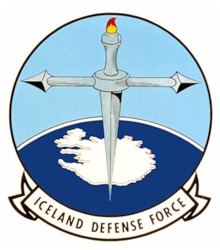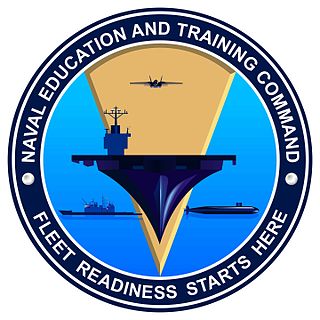Related Research Articles
In modern use, the order of battle of an armed force participating in a military operation or campaign shows the hierarchical organization, command structure, strength, disposition of personnel, and equipment of units and formations of the armed force. Various abbreviations are in use, including OOB, O/B, or OB, while ORBAT remains the most common in the United Kingdom. An order of battle is distinct from a table of organisation, which is the intended composition of a given unit or formation according to the military doctrine of its armed force. Historically, an order of battle was the order in which troops were positioned relative to the position of the army commander or the chronological order in which ships were deployed in naval situations.

The Goldwater–Nichols Department of Defense Reorganization Act of October 4, 1986 made the most sweeping changes to the United States Department of Defense since the department was established in the National Security Act of 1947 by reworking the command structure of the U.S. military. It increased the powers of the chairman of the Joint Chiefs of Staff and implemented some of the suggestions from the Packard Commission, commissioned by President Reagan in 1985. Among other changes, Goldwater–Nichols streamlined the military chain of command, which now runs from the president through the secretary of defense directly to combatant commanders, bypassing the service chiefs. The service chiefs were assigned to an advisory role to the president and the secretary of defense, and given the responsibility for training and equipping personnel for the unified combatant commands.

The Iceland Defense Force was a military command of the United States Armed Forces from 1951 to 2006. The IDF, created at the request of NATO, came into existence when the United States signed an agreement to provide for the defense of Iceland, which has only limited defense forces.

A military staff or general staff is a group of officers, enlisted and civilian staff who serve the commander of a division or other large military unit in their command and control role through planning, analysis, and information gathering, as well as by relaying, coordinating, and supervising the execution of their plans and orders, especially in case of multiple simultaneous and rapidly changing complex operations. They are organised into functional groups such as administration, logistics, operations, intelligence, training, etc. They provide multi-directional flow of information between a commanding officer, subordinate military units and other stakeholders. A centralised general staff results in tighter top-down control but requires larger staff at headquarters (HQ) and reduces accuracy of orientation of field operations, whereas a decentralised general staff results in enhanced situational focus, personal initiative, speed of localised action, OODA loop, and improved accuracy of orientation.
Network-centric warfare, also called network-centric operations or net-centric warfare, is a military doctrine or theory of war that aims to translate an information advantage, enabled partly by information technology, into a competitive advantage through the computer networking of dispersed forces. It was pioneered by the United States Department of Defense in the 1990s.
Mission-type tactics is a method of command and delegation where the military commander gives subordinate leaders a clearly-defined objective, high-level details such as a timeframe, and the forces needed to accomplish that objective. The subordinate leaders are given the planning initiative and freedom of execution: they decide on the methods to achieve the objective independently. This allows a high degree of flexibility at the operational and tactical levels of command, which allows for faster decision-making on the ground and frees the higher leadership from managing the tactical details to concentrate on the strategic picture. This may be contrasted with "Befehlstaktik" or command-type tactics.
Principles of war are rules and guidelines that represent truths in the practice of war and military operations.

The Naval Aviation Warfighting Development Center was formerly known as the Naval Strike and Air Warfare Center at Naval Air Station Fallon located in the city of Fallon in western Nevada. It is the center of excellence for naval aviation training and tactics development. NAWDC provides service to aircrews, squadrons and air wings throughout the United States Navy through flight training, academic instructional classes, and direct operational and intelligence support. The name was changed from NSAWC to NAWDC in June 2015 to align with the naming convention of the Navy's other Warfighting Development Centers (including Naval Surface and Mine Warfighting Development Center, Naval Information Warfighting Development Center, and the Undersea Warfighting Development Center.

The Naval Education and Training Command (NETC) is an enterprise-level shore command of the United States Navy with more than 19,000 military and staff personnel at more than 1,640 subordinate activities, sites, districts, stations, and detachments throughout the world, and was established in 1971. NETC recruits, trains and delivers those who serve the nation, taking them from "street to fleet" by transforming civilians into highly skilled, operational, and combat ready warfighters.

In the practice of international law, command responsibility is the legal doctrine of hierarchical accountability for war crimes, whereby a commanding officer (military) and a superior officer (civil) is legally responsible for the war crimes and the crimes against humanity committed by his subordinates; thus, a commanding officer always is accountable for the acts of commission and the acts of omission of his soldiers.
Mission command, also referred to as mission-type tactics, is a style of military command, which is derived from the Prussian-pioneered mission-type tactics doctrine, combines centralized intent with decentralized execution subsidiarity, and promotes freedom and speed of action, and initiative within defined constraints. Subordinates, understanding the commander's intentions, their own missions, and the context of those missions, are told what effect they are to achieve and the reason that it needs to be achieved. Subordinates then decide within their delegated freedom of action how best to achieve their missions. Orders focus on providing intent, control measures, and objectives and allow for greater freedom of action by subordinate commanders. Mission command is closely related to civilian management concept of workplace empowerment, and its use in business has been explored by writers such as Bungay (2011) and Tozer. It is advocated but not always used by the militaries of the United States, Canada, Netherlands, Australia and the United Kingdom. Mission command is compatible with modern military net-centric concepts, and less centralized approaches to command and control (C2) in general.

Command and control is a "set of organizational and technical attributes and processes ... [that] employs human, physical, and information resources to solve problems and accomplish missions" to achieve the goals of an organization or enterprise, according to a 2015 definition by military scientists Marius Vassiliou, David S. Alberts, and Jonathan R. Agre. The term often refers to a military system.
Area of responsibility (AOR) is a pre-defined geographic region assigned to Combatant commanders of the Unified Command Plan (UCP), that are used to define an area with specific geographic boundaries where they have the authority to plan and conduct operations; for which a force, or component commander bears a certain responsibility. The term may also be used in other countries worldwide but it originated within the United States Armed Forces. This system is designed to allow a single commander to exercise command and control of all military forces in the AOR, regardless of their branch of service.

In 1961 the United States Strike Command (STRICOM) was established at MacDill Air Force Base as a unified combatant command capable of responding to global crises. The name of the command was originally derived from the acronym for Swift Tactical Reaction In Every Known Environment (STRIKE). It integrated the CONUS-based forces of the Army's Continental Army Command and the Air Force's Composite Air Strike Force (CASF) and Tactical Air Command.
Truppenführung was a German Army field-manual published in two parts as Heeresdienstvorschrift 300: Part 1, promulgated in 1933, and Part 2 in 1934.
Swarming is a battlefield tactic designed to maximize target saturation, and thereby overwhelm or saturate the defences of the principal target or objective. Defenders can overcome attempts at swarming by launching counter-swarming measures that are designed to neutralize or otherwise repel such attacks.
The reconnaissance mission within the United States Marine Corps is divided into two distinct but complementary aspects; Marine Division Recon and Force Reconnaissance.

The Fleet Electronic Warfare Center (FEWC) is a subordinate organization of the Naval Network Warfare Command (NNWC), which was established in 2008 to be the center for US Navy fleet electronic warfare (EW) operational and tactical issues. It is currently located at Navy Information Dominance Forces (NIDF) Headquarters, in Suffolk, VA as an independent directorate.
Fleet Command is responsible for the command, operations, readiness, training and force generation of all ships, submarines, aircraft squadrons, diving teams, and shore establishments of the Royal Australian Navy. Fleet Command is headquartered at HMAS Kuttabul in Sydney, and is led by the Commander Australian Fleet (COMAUSFLT), also referred to as Fleet Commander Australia (FCAUST), which is a rear admiral (two-star) appointment.
A principal warfare officer (PWO), is one of a number of warfare branch specialist officers.
References
- 1 2 Worley 2006, p. 253.
- 1 2 McNamara 2001, p. 114.
- ↑ English 2007, p. 38.
- ↑ English 2007, p. 39.
- ↑ Mack 1998, p. 297.
- ↑ Mamikonian 2005, p. 25.